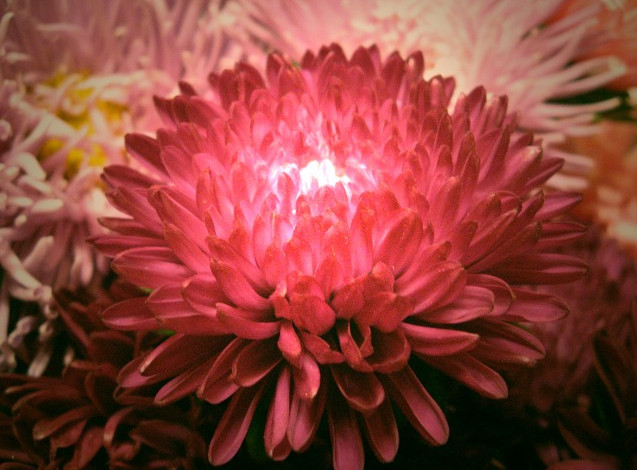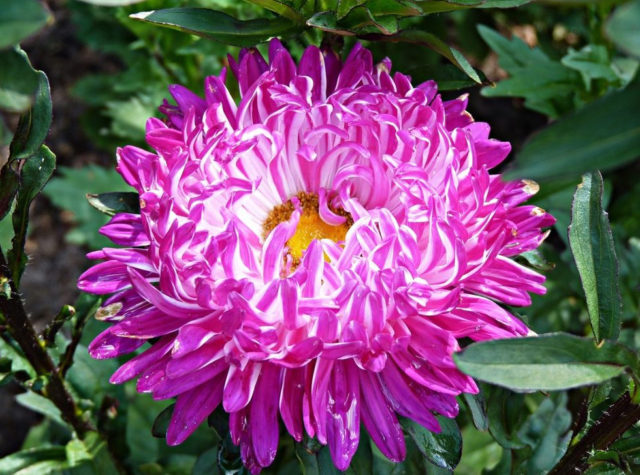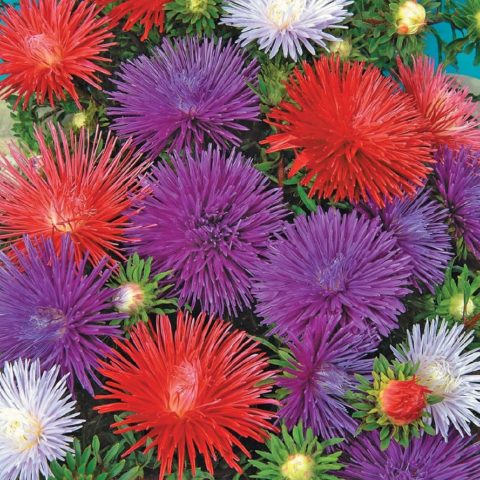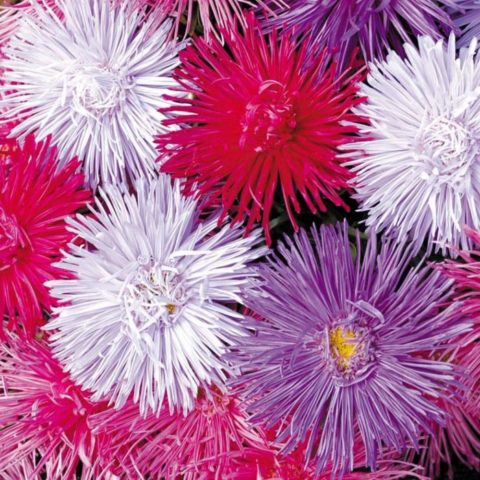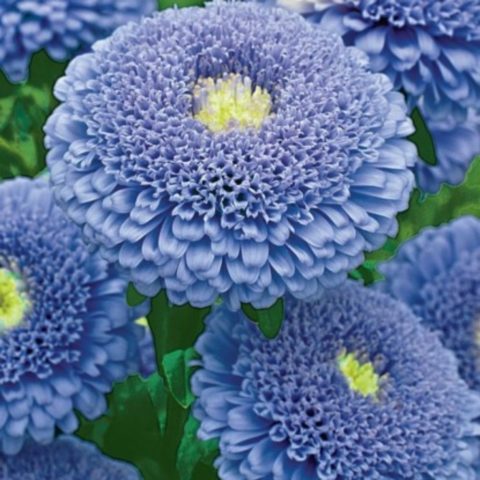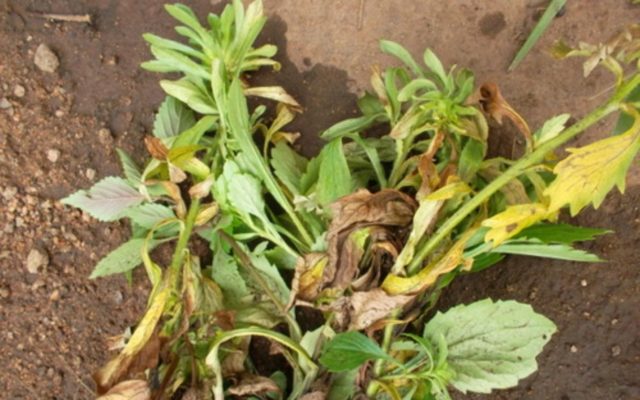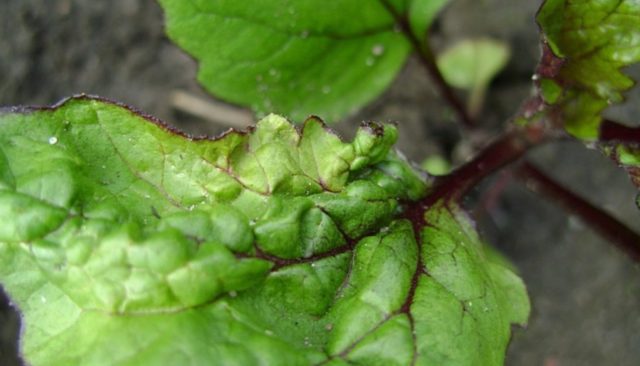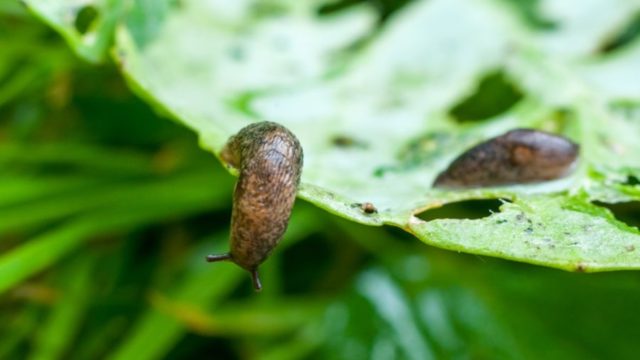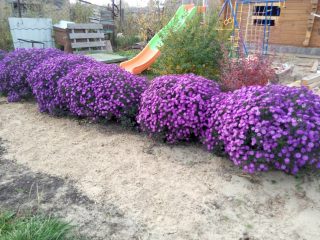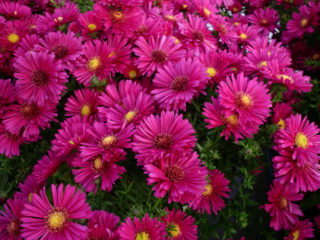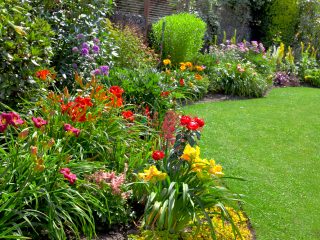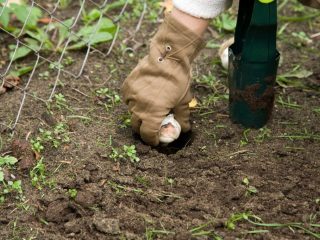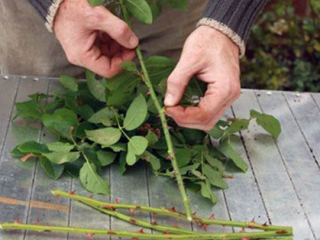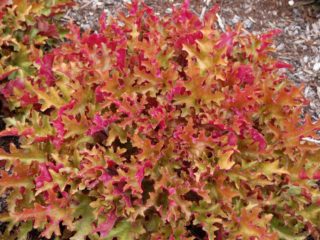Content
- 1 General description of Chinese aster
- 2 The best varieties of Chinese aster
- 3 Features of reproduction
- 4 Application in landscape design
- 5 Methods for growing Chinese aster from seeds
- 6 Growing Chinese aster from seeds at home
- 7 Planting and caring for Chinese aster in open ground
- 8 Caring for Chinese aster in open ground
- 9 Diseases and pests
- 10 Conclusion
Chinese aster is a herbaceous plant of the Asteraceae family. In botanical reference books it can be found under the name “Callistephus”. The culture is distinguished by a wide variety of colors and ease of care, which is why it has gained wide popularity. Different types of Chinese aster may differ not only in color, but also in the shape of the petals, plant height, and purpose. Therefore, every gardener can choose any options to suit his taste.
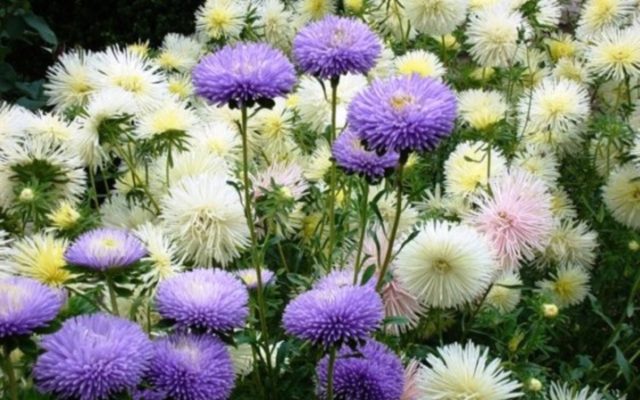
The aster bush can be spreading or pyramidal in shape
General description of Chinese aster
China is considered the homeland of callistephus, where the plant has been grown since ancient times, personifying elegance and beauty.The flower was secretly brought to European countries in the 17th century by a French monk. Since then, the aster began to travel around the world.
Legends and interesting facts
Translated from Latin, “aster” means “star”. Therefore, the flower personifies the dream of the unknown, is a talisman and God’s gift to man. In Greece, it is believed that an aster planted at the entrance can protect the house from harm and trouble.
There is a legend in China that two monks, trying to climb to the stars, climbed the highest mountain in Altai. But when they reached the top, they were disappointed. The stars were also inaccessible and distant, as before. Tired and hungry, they returned back, and at the foot of the mountain they saw a whole clearing with beautiful flowers. And then they realized that there are stars not only in the sky, but also on the earth. The monks called the plants asters. And from then on they began to grow them in the monastery.
There is also another belief that the Chinese aster grew from a speck of dust that fell to Earth from a star. That's why her buds look so much like her. And if you go out into the garden at night, you can hear a whisper. These are the stars in the sky communicating with asters.
Chinese aster - perennial or annual
"Callistephus" is an annual plant. But unlike perennial species, Chinese aster is characterized by larger flowers, a huge variety of shades and a compact bush shape.
The height of the plant varies from 20 to 90 cm. Aster is distinguished by erect, flexible shoots that branch extensively. The leaves are oval, with a serrated edge and a sharp tip. The flowers are fluffy baskets. But in fact, they are inflorescences and consist of two types of flowers - reed and tubular, which many people mistake for petals.
The marginal reed flowers can be of different shades, except orange, green and black. And the tubular ones, which are located in the center, come only in yellow. Moreover, in terry varieties they are practically invisible.
The best varieties of Chinese aster
Chinese aster is a herbaceous plant for open ground. Thanks to selection, about 500 species of this crop were bred.
Among them:
- Erfurt dwarf. A low-growing species bred in Germany. It is characterized by a compact pyramidal bush, the height of which reaches 20-30 cm. It forms large inflorescences with a diameter of up to 10 cm. The color is in the classic color scheme. The first buds open after 3 months.
- Gray-haired lady. Peony-shaped aster is 70 cm high. A characteristic feature is the silver-white tips of the petals. The main shade of this series can be pink or lilac-blue. The bush has a compressed pyramidal shape and produces about 10 flower stalks per season. The “Grey-haired Lady” has double or semi-double inflorescences, 9-12 cm in diameter. The first buds open in July.
- Unique. A needle-shaped type of Chinese aster, distinguished by a wide choice of colors and a delicate aroma. Forms tall bushes up to 70 cm, with numerous branches. Radiant inflorescences reach 13 cm in diameter.
- Hartz. A spectacular needle-shaped variety mixture with huge inflorescences with a diameter of 16-18 cm. The height of the bushes is 70 cm. It forms strong shoots, so it is suitable for cutting. The long needle-petals are densely planted and slightly curled in the center. The Hartz series of Chinese aster, as seen in the photo, is distinguished by a wide variety of shades.
- Pampushka. Pompom variety of the plant, which includes one- and two-color shades. Forms compact branched bushes 50 cm high. The marginal flowers form a long, wide skirt, and the central flowers are dense and short.
Features of reproduction
Chinese asters, unlike perennial species, must be planted every year. The plant reproduces only by seeds. They should be collected in the fall, after full ripening.
Application in landscape design
The variety of callistephus species allows the plant to be used for landscaping. Dwarf varieties of Chinese aster are ideal for ridges and borders. And tall species are used for group plantings.
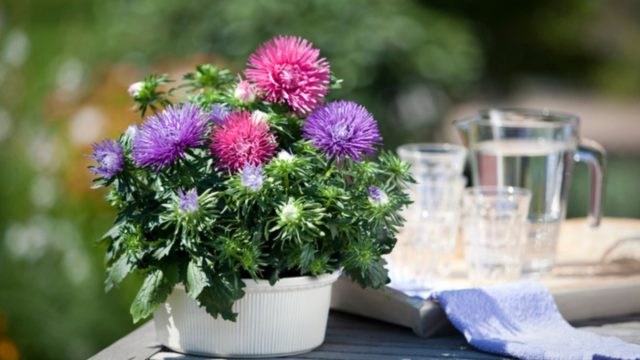
Dwarf forms of Chinese aster are suitable for growing in containers
It is good to combine the Chinese aster with spring bulbous flowers, since after the latter have finished flowering, it just begins to form buds and grow bushes, thereby preserving the decorative appearance of the flowerbed. Ideal partners for callistephus are calendula and marigold.
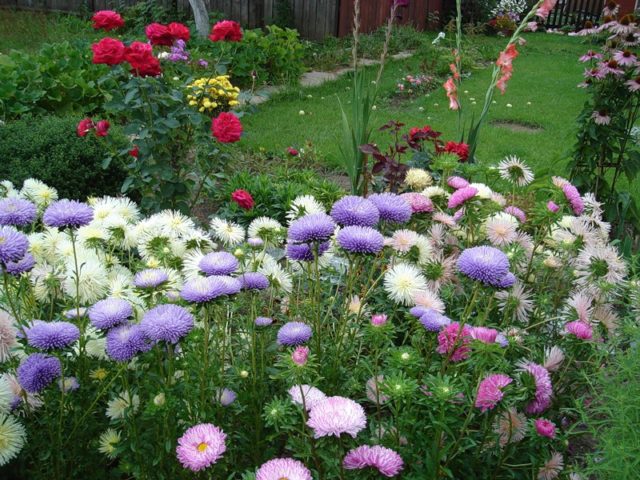
Aster gets along easily and goes well with any garden flowers
Methods for growing Chinese aster from seeds
Chinese aster can be grown in seedlings and without seedlings. In the first case, flowering occurs much earlier and allows you to collect ripened seeds at the end of the season. In the second case, the buds open only in August.
Growing Chinese aster from seeds at home
This method is more reliable, as it allows you to track the growth of Chinese aster seedlings from the beginning until planting in open ground.This significantly increases the number of seedlings, but requires hardening off before planting in the ground.
When to sow Chinese asters for seedlings
When growing Chinese aster from seeds, seedlings can be planted in early April and continued until the first half of May. Early species bloom after 90-95 days, and later ones after 110 days.
Preparing containers and soil
To plant Chinese aster for seedlings, you need to select wide but shallow bowls 10 cm high with drainage holes. Each variety should be planted in a separate container. A suitable soil can be prepared by mixing turf, sand and humus in a 1:1:1 ratio and adding 200 g of wood ash to 1 bucket of substrate. To disinfect the soil, it is necessary to water it with a solution of potassium permanganate.
Algorithm for planting Chinese aster for seedlings
The procedure for planting Chinese aster does not require complicated steps. Therefore, anyone, even a novice florist, can do it.
Procedure:
- Place a 1 cm thick layer of drainage on the bottom of the container.
- Pour the substrate on top, level and compact.
- Water the soil.
- Using a wooden stick, make furrows 0.5 cm deep.
- Place the seeds evenly in them and sprinkle with soil.
- Maintain a distance between rows of 2 cm.
- Cover the containers with glass or film.
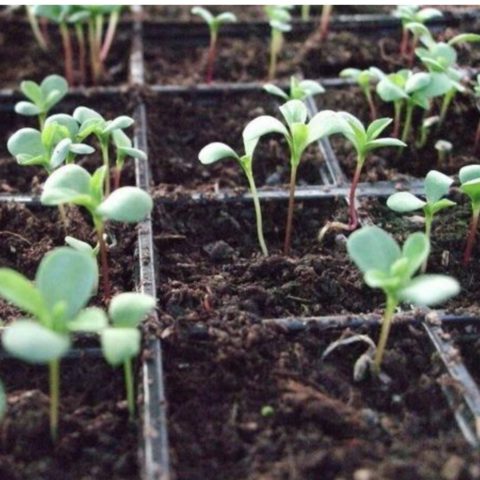
Chinese aster seeds germinate in 7-8 days
Seedling care
When seedlings appear, the containers must be moved to a bright place and the maintenance mode reduced to 15 degrees.This will slow down the growth of the above-ground part and stimulate the development of roots.
Basic care consists of regular watering as the substrate dries. As soon as the Chinese aster seedlings grow a little and become stronger, they need to be adapted to external conditions. To do this, you should initially remove the glass for 30 minutes, and with each subsequent day increase the interval by another half hour. After a week, the cover can be removed.
When 1-2 pairs of true leaves are formed, Chinese aster seedlings should be planted in separate containers. The same soil can be used as for seeds.
Transplantation into the ground
It is necessary to plant Chinese aster seedlings grown from seeds in open ground when the likelihood of return frosts completely disappears. The optimal period is considered to be the second half of May or the beginning of June, depending on the region.
By this time, the plant should be 7 cm high and have 5-6 true leaves. When planting, maintain a distance of 20 cm between seedlings.
Planting and caring for Chinese aster in open ground
Sowing seeds can be done directly in open ground. With this method of cultivation, the Chinese aster turns out to be more hardy.
Deadlines
Planting Chinese aster seeds in the ground can be done in spring and autumn. In the first case, this should be done in the second half of May, when the soil warms up to a depth of 15-20 cm.
In the second case, it is recommended to sow at the end of November so that the seeds do not have time to germinate before frost. Planting Chinese aster before winter can be used in the southern regions.
Site selection and soil preparation
For Chinese aster, open sunny areas should be selected, but growing Chinese aster in partial shade is also permissible. Maximum decorative qualities are manifested when planted in light, fertile soil with a neutral acidity level.
The bed for the Chinese aster should be prepared 2 weeks in advance. It needs to be dug up, cleared of weeds and humus (4 kg), superphosphate (40 g) and potassium sulfide (3 g) added to the soil for each square meter.
Sowing seeds
Before planting, the area should be leveled and loosened to a depth of 4-6 cm. Then make furrows at a distance of 15 cm and water them. Then spread the seeds and sprinkle them with soil. The first watering should be done on day 3-4.

Seeds are planted in open ground in three stages
Caring for Chinese aster in open ground
The Chinese aster belongs to the category of unpretentious plants, so caring for it is not at all difficult.
The basic rule is to regularly loosen the soil between the rows after rain or watering and timely removal of weeds. It is also important to hill up the bushes to a height of 6-8 cm before branching, which stimulates the growth of the root system and gives stability to the plants. Chinese aster easily tolerates drought, but does not tolerate stagnation of moisture in the soil. Therefore, it needs to be watered rarely, but abundantly, at the rate of 30 liters per 1 square meter. m.
One-year-old aster should be fed three times a season. The first time during the period of active growth of shoots. At this stage, 30 g of ammonium nitrate per 10 liters of water should be used. Fertilize the second and third time during the formation of buds and flowering. During this period, it is necessary to use superphosphate (50 g) and potassium sulfate (40 g) for the same volume of water.
Diseases and pests
The Chinese aster, like its perennial relative, is susceptible to diseases and pests. Therefore, when characteristic signs appear, it is recommended to take urgent measures.
Possible problems:
- Fusarium. Affects adult plants. A characteristic sign is a sharp yellowing of the bush on one side followed by drying out. Sick plants cannot be treated, so they need to be burned. As a preventive measure, the Chinese aster should not be planted in the same bed for 5 years. Most often, the cause is fresh manure, so only humus should be used when growing.
- Bud aphid. It attacks the Chinese aster at the seedling stage, which leads to deformation of the leaves. To combat aphids, bushes should be treated with Inta-Vir and Fitoverm.
- Slugs. The pest attacks plants in conditions of high humidity. A sign of damage is holes on the leaves. To combat it, it is recommended to pour wood ash and gravel at the base of the bushes.
Conclusion
Chinese aster is a flower for open ground, which was grown in ancient times. But thanks to the efforts of breeders, the plant remains relevant to this day, and is also widely used in landscape design. This popularity is explained by its high decorative qualities and ease of care.
